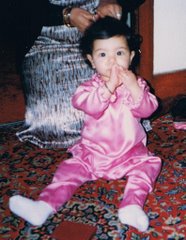
I wanted to wish everyone a happy vaisakhi. I know everyone knows the meaning and the significance of it, but I thought I would add this for today.
Guru Gobind Singh, the Tenth Guru of the Sikhs founded the Khalsa (Community of the Pure) at the Baisakhi gathering in 1699, at Keshgarh Sahib near Anandpur. Guru Gobind Singh, had organised for followers from all over India to meet him at the Basakhi Fair in Anandpur.
Guru Gobind Singh emerged from a tent with a sword, and asked for volunteers to offer his life for his faith. A young Sikh volunteered, followed the Guru into a tent. Shortly after, the Guru reappeared alone with his sword covered with blood, and asked for a second volunteer. Another Sikh stepped forward and again the Guru took him into the tent, and re-appeared alone, his sword covered in more blood. This was repeated for a third, fourth and fifth volunteer. The crowd became very unnerved, as many believed that the Guru had killed the five Sikhs. He soon came out of the tent again, this time followed by all five Sikhs who were alive and well and dressed in turbans and other symbols that have since become symbols of Sikh identity. He called the five Sikhs the Panj Pyare - the beloved five.
Guru Gobind Singh emerged from a tent with a sword, and asked for volunteers to offer his life for his faith. A young Sikh volunteered, followed the Guru into a tent. Shortly after, the Guru reappeared alone with his sword covered with blood, and asked for a second volunteer. Another Sikh stepped forward and again the Guru took him into the tent, and re-appeared alone, his sword covered in more blood. This was repeated for a third, fourth and fifth volunteer. The crowd became very unnerved, as many believed that the Guru had killed the five Sikhs. He soon came out of the tent again, this time followed by all five Sikhs who were alive and well and dressed in turbans and other symbols that have since become symbols of Sikh identity. He called the five Sikhs the Panj Pyare - the beloved five.
Then the Guru put water in a bowl for sprinkling over the five in a simple initiation ceremony. He said prayers as he stirred the water with a short steel sword; symbolising the need for strength. The Guru's wife, Mata Sundri, then came forward and placed some sugar crystals into the holy water or amrit as a reminder that strength must always be balanced by sweetness of temperament. After completing his prayers, the Guru then sprinkled the amrit over the five.
He declared them to be the first members of a new community of equals, to be called the Khalsa, meaning "pure". These "saint soldiers" were to dedicate their lives to the service of others and the pursuit of justice for people of all faiths. The Panj Pyare were asked to wear five distinctive symbols of their new identity, The Five Ks.
In a move to end social divisions the five dropped their surnames - traditionally associated with one's caste - and took the common name Singh, meaning "lion", a reminder of the need for courage. At the same time, the Guru gave Sikh women the name or title Kaur, meaning "princess", to emphasise dignity and complete equality.
The Guru then knelt before the five and asked them to initiate him. Hence, the Khalsa became a community in which master and disciple were equal.
For Sikhs, this seasonal festival also has great importance as the founding of the Akal Khalsa (Soldiers of the Timeless One) at Anandpur Sahib. The Akal Khalsa played an important role in resistance against Mughal rule. For many centuries after that, the first male child of many Hindu families in Punjab was ordained as a Sikh in order for him to train and become a warrior and fight for the people. Other male children used to take care of the family, parents and the land.

2 comments:
Happy Vaisakhi to all. Thank you for the article.
Happy Vaisakhi to the family!
Post a Comment